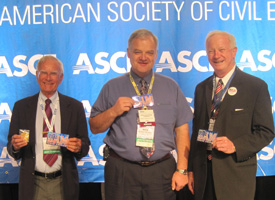Civil engineering professionals across the nation gathered last weekend in Las Vegas, N.V. to celebrate the 75th anniversary of the completion of the Hoover Dam. The American Society of Civil Engineers (ASCE) held a special symposium at the organization's 140th Annual Civil Engineering Conference to commemorate what is considered to be one of the greatest dam design and construction projects of the 21st century.
"It was great to see so many people involved in our program to recount the history of the Hoover Dam project," said Jerry Rogers, professor of civil engineering at the University of Houston. Rogers served as one of three editors for the conference proceedings, a collection of papers outlining various aspects of the dam project. In fact, his paper titled "The New Town of Boulder City: City Planning and Infrastructure Engineering for Hoover Dam Workers" was one of 20 papers selected nationally for inclusion in the proceedings.
Specifically, Rogers' paper outlines the process the Bureau of Reclamation set in place to select the appropriate location for the construction of the city, which included everything from the appropriate soil conditions for living quarters to the variation in temperature to give workers a break from the harsh conditions of the dam project working environment. The paper provides detail into city planning such as the 1,500 buildings built to support the more-than-5000 dam workers and urban infrastructure projects such as running water from the Colorado River to the city site six miles away from the dam.
"Though the focus of the symposium was more on the design and construction aspects of the dam project from a civil engineering prospective, I wanted to outline the economic infrastructure developed to support multi-year projects such as the Hoover Dam," said Rogers, who has chaired several historical symposia for the ASCE Annual Conference and has subsequently published a number of anthologies on the history of civil engineering water and environmental projects, engineers and programs printed by the ASCE Press. "Boulder City may not be considered nearly as important but the project could not have reached completion without it."
Rogers utilizes these collection of papers within his courses at the Cullen College of Engineering to give students an opportunity to study and summarize civil engineering from a historical prospective.
"These collections have provided a way for us to engage students in civil engineering history," said Rogers. "I plan to use the Hoover Dam Symposium Proceedings next spring and fall in the section of my course and I hope students will learn some of the fundamentals of civil engineering design by studying the historical aspects of great projects like the Hoover Dam."
